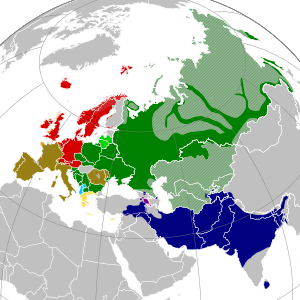กลุ่มภาษาอินโด-อิเรเนียน
กลุ่มภาษาอินโด-อิเรเนียน (อังกฤษ: Indo-Iranian languages; มีอีกชื่อว่า กลุ่มภาษาอินโด-อิเรนิก (Indo-Iranic languages)[2][3] หรือ กลุ่มภาษาอารยัน (Aryan languages)[4] เป็นสาขาในตระกูลภาษาอินโด-ยูโรเปียนที่มีผู้พูดมากที่สุดและอยู่ทางตะวันออกเฉียงใต้สุด โดยมีผู้พูดมากกว่า 1.5 พันล้านคน มีบรรพบุรุษเป็นอินโด-อิเรเนียนดั้งเดิม (มีอีกชื่อว่า อารยันทั่วไป) ซึ่งเริ่มมีผู้พูดประมาณปลายสหัสวรรษที่ 3 ก่อนคริสตศักราช ปัจจุบันแตกออกเป็นสามสาขาคืออินโด-อารยัน, อิหร่าน และนูริสถาน ส่วนดาร์ดิก สาขาเอกเทศที่สี่ เคยอยู่ในกลุ่มภาษานี้ แต่นักวิชาการโดยทั่วไปในปัจจุบันมักจัดให้กลุ่มภาษาดาร์ดิกเป็นสมาชิกในอดีตของสาขาอินโด-อารยัน[5]
| กลุ่มภาษาอินโด-อิเรเนียน | |
|---|---|
| อารยัน | |
| ภูมิภาค: | เอเชียใต้, กลาง, ตะวันตก, ยุโรปตะวันออกเฉียงใต้และคอเคซัส / รวมผู้พูด = ประมาณ 1.5 พันล้านคนใน 15 ประเทศ |
| การจําแนก ทางภาษาศาสตร์: | อินโด-ยูโรเปียน
|
| ภาษาดั้งเดิม: | อินโด-อิเรเนียนดั้งเดิม |
| กลุ่มย่อย: | |
| ISO 639-5: | iir |
| กลอตโตลอก: | indo1320[1] |
 บริเวณสาขาอินโด-ยูโรเปียนในยูเรเชีย:
อินโด-อิเรเนียน | |
ภาษา
แก้กลุ่มภาษาอินโด-อิเรเนียนแบ่งออกเป็น 3 กลุ่ม:
มีผู้พูดกลุ่มภาษาอินโด-อิเรเนียนมากกว่า 1.5 พันล้านคน ภาษาที่มีผู้พูดมากที่สุดอยู่ในกลุ่มอินโด-อารยัน: ภาษาฮินดูสตานี (ประมาณ 590 ล้านคน เพราะสำมะโนอินเดียมักรวมภาษาโภชปุรี (40 ล้านคน), ภาษาอวธี (40 ล้านคน), ภาษาไมถิลี (35 ล้านคน), ภาษามาร์วารี (30 ล้านคน), ภาษาราชสถาน (20 ล้านคน), ภาษาฉัตตีสครห์ (18 ล้านคน) และกุเมานี (2.1 ล้านคน) เป็นสำเนียง),[6] ภาษาเบงกอล (205 ล้านคน),[7] ภาษาปัญจาบ (100 ล้านคน), ภาษามราฐี (90 ล้าน), ภาษาคุชราต (50 ล้านคน), ภาษาโอริยา (35 ล้านคน), ภาษาสินธี (25 ล้านคน), ภาษาอัสสัม (24 ล้านคน), ภาษาสิงหล (19 ล้านคน), ภาษาเนปาล (17 ล้านคน) และภาษามณีปุระพิษณุปุระ (12 ล้านคน)[8] ในสาขาอิเรเนียน ภาษาที่มีผู้พูดมากที่สุดคือภาษาเปอร์เซีย (90 ล้านคน),[9] ภาษาปาทาน (ประมาณ 70 ล้านคน), ภาษาเคิร์ด (35 ล้านคน),[10] และภาษาบาโลจ (8 ล้านคน)
อ้างอิง
แก้- ↑ Nordhoff, Sebastian; Hammarström, Harald; Forkel, Robert; Haspelmath, Martin, บ.ก. (2013). "Indo-Iranian". Glottolog 2.2. Leipzig: Max Planck Institute for Evolutionary Anthropology.
- ↑ D. D. Mahulkar (1990). Pre-Pāṇinian Linguistic Studies. Northern Book Centre. ISBN 978-81-85119-88-5.
- ↑ Annarita Puglielli; Mara Frascarelli (2011). Linguistic Analysis: From Data to Theory. Walter de Gruyter. ISBN 978-3-11-022250-0.
- ↑ Jadranka Gvozdanović (1999). Numeral Types and Changes Worldwide. Walter de Gruyter. p. 221. ISBN 978-3-11-016113-7.: "The usage of 'Aryan languages' is not to be equated with Indo-Aryan languages, rather Indo-Iranic languages of which Indo-Aryan is a subgrouping."
- ↑ Bashir, Elena (2007). Jain, Danesh; Cardona, George (บ.ก.). The Indo-Aryan languages. p. 905. ISBN 978-0415772945.
'Dardic' is a geographic cover term for those Northwest Indo-Aryan languages which [..] developed new characteristics different from the IA languages of the Indo-Gangetic plain. Although the Dardic and Nuristani (previously 'Kafiri') languages were formerly grouped together, Morgenstierne (1965) has established that the Dardic languages are Indo-Aryan, and that the Nuristani languages constitute a separate subgroup of Indo-Iranian.
- ↑ Edwards, Viv. "Urdu Today". BBC.
- ↑ Thompson, Irene. "Bengali". AboutWorldLanguages. สืบค้นเมื่อ 29 March 2013.
- ↑ "Census of India: Family-wise grouping of the 122 Scheduled and Non-Scheduled Languages -2001". www.censusindia.gov.in.
- ↑ Noack, Rick. "The future of language". Washington Post (ภาษาอังกฤษ). สืบค้นเมื่อ 2020-03-27.
- ↑ CIA- The World Factbook: 14.7 million in Turkey (18%)[1] เก็บถาวร 2021-01-10 ที่ เวย์แบ็กแมชชีน[ไม่อยู่ในแหล่งอ้างอิง], 4.9–6.5 million in Iraq (15-20%)[2][ไม่อยู่ในแหล่งอ้างอิง], 8 million in Iran (10%)"Archived copy". สืบค้นเมื่อ 31 มีนาคม 2011.[ไม่อยู่ในแหล่งอ้างอิง] (all for 2014), plus several million in Syria, neighboring countries, and the diaspora
ข้อมูล
แก้- Chakrabarti, Byomkes (1994). A comparative study of Santali and Bengali. Calcutta: K.P. Bagchi & Co. ISBN 81-7074-128-9
- Nicholas Sims-Williams, บ.ก. (2002). Indo-Iranian Languages and Peoples. Oxford University Press.
อ่านเพิ่ม
แก้- "Contact and change in the diversification of the Indo-Iranic languages" (PDF). Dr. Russell Gray.
- Pinault, Georges-Jean. "Contacts religieux et culturels des Indo-Iraniens avec la civilisation de l'Oxus". In: Comptes rendus des séances de l'Académie des Inscriptions et Belles-Lettres, 149ᵉ année, N. 1, 2005. pp. 213–257. DOI:https://doi.org/10.3406/crai.2005.22848 ; www.persee.fr/doc/crai_0065-0536_2005_num_149_1_22848
- Pinault, Georges-Jean. "La langue des Scythes et le nom des Arimaspes". In: Comptes rendus des séances de l'Académie des Inscriptions et Belles-Lettres, 152e année, N. 1, 2008. pp. 105–138. DOI:https://doi.org/10.3406/crai.2008.92104 ; www.persee.fr/doc/crai_0065-0536_2008_num_152_1_92104
- Baly, Joseph. Eur-Aryan roots: With their English derivatives and the corresponding words in the cognate languages compared and systematically arranged. Vol. 1. K. Paul, Trench, Trubner & Company, Limited, 1897.
แหล่งข้อมูลอื่น
แก้- Swadesh lists of Indo-Iranian basic vocabulary words (from Wiktionary's Swadesh-list appendix)